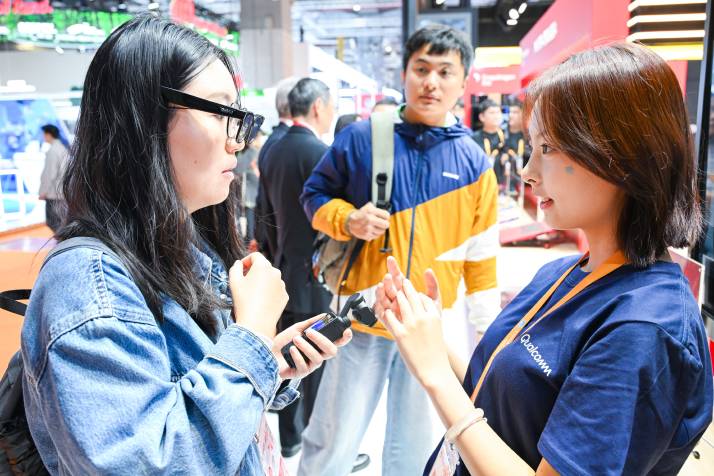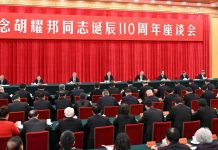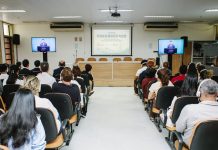
The annual China International Import Expo (CIIE) is no longer merely one of the world’s largest trade fairs. Now in its eighth edition, the Shanghai event has cemented its status as the world’s premier “First Show Stage”—a critical launchpad where global innovators debut their most disruptive technologies and visionary products.
Held from November 5 to 10, this year’s CIIE hosted participants from 155 countries, regions and international organizations, including 290 Fortune 500 companies and industry-leading firms. With over 600 more exhibitors than last year, the total exhibition space and overall participation hit a new high. The value of intended deals exceeded $83.4 billion.
Hub for global firsts
Data from the CIIE Bureau, the organizer of the expo, showed a total of 461 products, technologies and services made their China debuts at this year’s event, with over 200 of those also being global debuts. Notably, 170 overseas enterprises and 27 institutions have attended all eight editions of the CIIE, seeing the expo as an indispensable annual fixture for tapping the world’s second largest consumer market.
At a news conference on November 11, Lin Jian, a spokesperson for the Ministry of Foreign Affairs, said the Chinese market is increasingly acting as a platform for the world to leverage open cooperation, reaping benefits and applying pioneering technological innovation. This ethos of collaboration permeated the six-day expo, linking global research and development (R&D) efforts across diverse sectors to China’s vast, rapidly evolving consumer demands.
“There is no doubt that the size of the China market is always one of the most triggering ideas,” Tino Zeiske, CEO of German retailer and wholesaler Metro Commerce Group, told Beijing Review.
Following 30 successful years of operation in China, Metro has now expanded its physical footprint beyond 63 cities. Zeiske detailed the company’s strategic integration with Chinese partners like the e-commerce app Dmall to accelerate e-commerce, AI, and technical solutions, emphasizing a continuous adaptation of product lines based on rapid local consumer feedback.
The auto sector demonstrated radical localization. Jörg Buchheim, CEO of Webasto Group, a German manufacturer of automotive roof and thermal systems, said he views the CIIE as a crucial hub for connecting with clients and, most importantly, exploring next-generation innovations specifically for Chinese consumers.
Buchheim proudly introduced Webasto’s innovative flexible car roof—a product developed in China and exhibited at this year’s CIIE. Designed for variable opening configurations, it will debut in the Chinese market later this year before rolling out in the U.S. and Europe. He underlined that the company had launched three innovation centers in China to facilitate fast, open interaction with domestic automakers like Xiaomi, Geely and Li Auto.
Further pushing the boundaries of engineering, Michelin, the French tire and mobility technology company, presented a prototype of airless wheels for lunar rovers. This extreme-weather technology is designed to withstand temperatures ranging from 100 down to minus 240 degrees Celsius, ensuring stability on the moon’s rugged terrain.
Materials and personal tech
U.S. technology startup Shift Robotics chose this year’s CIIE for the Asian debut of its intelligent powered shoes, which use a built-in AI algorithm to enable wearers to walk at running speeds, up to 11 km per hour.
“I didn’t anticipate that so many people would be interested in trying it,” said Xunjie Zhang, founder and CEO of Shift Robotics, noting the overwhelming response exceeded all expectations for their first foray into the Asian market. “Through the expo, we are also exploring connections with local distributors.”
This year, the CIIE inaugurated a dedicated new materials area. This platform immediately attracted companies like Nippon Paint Holdings. Wee Siew Kim, Co-President of the Japanese paint, coatings and new materials group, said the high standards of the new section inspired their participation.
The company chose this year’s CIIE for the global debut of the Nippon Paint Smart Road Marking Paint, which dramatically enhances night-time visibility, extending recognition distance by up to 160 meters and giving drivers up to 10 extra seconds of reaction time. The paint is also designed to be highly recognizable by autonomous vehicles, showcasing a future-forward approach.
Nippon Paint executives used the CIIE to affirm their strategic plans: increased investment and expanded R&D capabilities in China. They said the company views investing in China, with its powerful supply chain and research strength, as inherently investing in the future.
Shiya Amano, head of Japan External Trade Organization, a government-related organization that works to promote mutual trade and investment between Japan and the rest of the world, echoed this sentiment, confirming in a news briefing Japanese firms’ willingness to collaborate with Chinese counterparts in robotics, AI and more.

For a healthy life
The 70,000-square-meter Medical Equipment and Healthcare Products Exhibition Area showcased many new medical innovations. Johnson & Johnson MedTech, the global medical technology and device company of U.S. healthcare giant Johnson & Johnson, introduced its ETHICON™ 4000, the world’s first 3D stapling laparoscopic surgical stapler. It was the Asian debut of this breakthrough technology, which aims to reduce the risks of bleeding and leakage associated with traditional planar stapling.
The cutting-edge field of brain-computer interface (BCI) was spotlighted by German medical equipment and imaging technology company Siemens Healthineers. Their BCI solution includes core imaging devices that establish a “mesoscopic” level imaging platform, which take clear “middle-scale” brain pictures to support BCI surgeries. Two of these devices were previously instrumental in the U.S. neurotechnology company Neuralink’s clinical trials, helping make invasive BCI surgery “visible, planable, and controllable.”
Edwards Lifesciences, a U.S. company that produces heart valves, highlighted its local initiatives—faster product launches, clinical support, deeper partnerships—at the CIIE. Wayne Markowitz, Corporate Vice President for Asia Pacific, said the company regards CIIE as a platform to collaborate with experts to advance heart disease care and merge global innovation with local needs. Markowitz hailed the CIIE as “an important platform for global innovation to enter the Chinese market.”
This localized innovation trend was crystallized by GE HealthCare China, the local subsidiary of the U.S. medical technology firm. As an attendee of all eight editions of the CIIE, the company presented nearly 40 innovative solutions, with a remarkable 60 percent primarily developed by the Chinese team—a new record for the concentration of local innovation. Song Weiqun, CEO of GE HealthCare China, said, “China is not only GE HealthCare’s largest market outside of the United States, but also an important component of our innovation and advanced manufacturing layout.”
The expo also featured significant advancements in oncology. AstraZeneca, a British multinational pharmaceutical company, exhibited two of its latest breast cancer drugs approved in China for the first time. Simultaneously, Abbott, the U.S. healthcare company specializing in diagnostics and nutrition, responded to the demand for precision medicine by showcasing multiple “China-debut” medical nutrition solutions and technologies like biosensors and smart diagnostics.
By setting a record for global product debuts and cementing billions in committed deals, the Eighth CIIE has solidified its role as a dynamic engine for technological advancement. For the world’s leading innovators, the consistent message is clear: The Chinese market has become the definitive arena for scaling the future of global technology. –The Daily Mail-Beijing Review News exchange item




